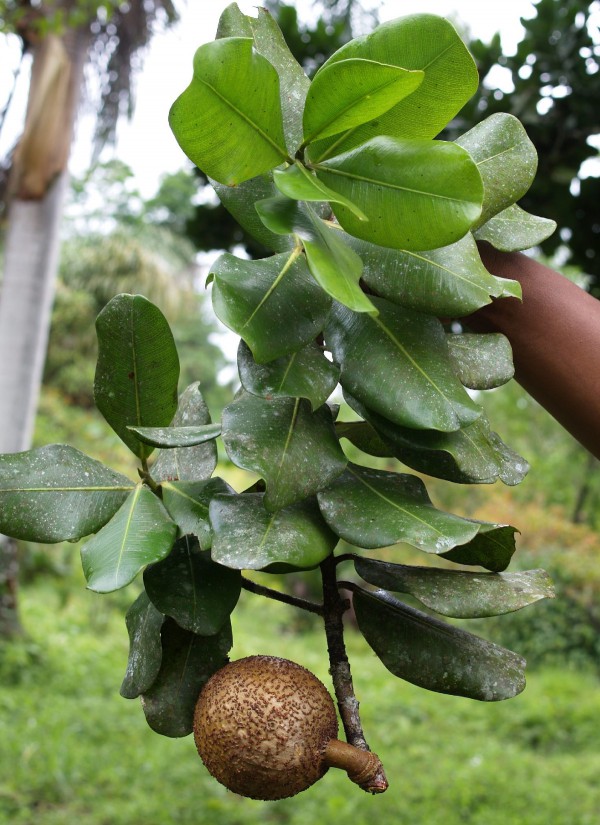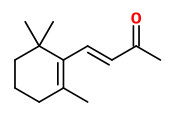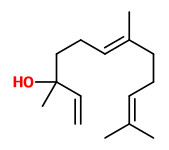Mammea americana L. - Calophyllaceae - abricó (span.), mamey apple, mammee apple, abrico, Mammiapfel
Evergreen tree, native to the Caribbean and tropical South America, cultivated and naturalized in Central America and elsewhere.
„Mammea americana is often confused with the unrelated but similar looking mamey sapote tree (Pouteria sapota), whose fruit is also called mammee or mamey.“ http://en.wikipedia.org/wiki/Mammea_americana
„β-Ionone (22%), 2-methylbutyric acid (12.5%), E-farnesol (4.6%), and nerolidol (3.8%) were identified by gas chromatography and gas chromatography-mass spectrometry as the major constituents of the volatile fraction of the fresh fruit of mammee apple…“
[Sagrero-Nieves, L., De Pooter, H. L., Van Wassenhove, F. A., Major volatile constituents from the fruit of mammee apple ( Mammea americana L.). Journal of Food Composition and Analysis, Vol.2(4), 1989, 382-385]
„The volatile constituents of mammee apple (Mammea americana) fruit pulp obtained by liquid-liquid extraction were analyzed by capillary GC and capillary GC-MS. In total, 51 components (40 of which are identified for the first time in mammee apple) were identified with methyl 3-hydroxy-2(S)-methyl propanoate pure enantiomer and 2-methyl butanoic acid with ee 98.5% S being the major components. Glycosidically bound aroma compounds were identified by capillary GC and capillary GC-MS after isolation of the glycosidic fraction obtained by Amberlite XAD-2 adsorption and methanol elution followed by hydrolysis with a commercial pectinase enzyme. In total 19 bound aroma compounds (aglycones) were identified. These aglycones mainly consisted of carboxylic acids and C13-norisoprenoids of which 2-methyl butanoic acid, 4-hydroxy-β-ionone and 4-oxo-β-ionol are the most representative. Additionally, with the aid of capillary GC-MS (EI and NCI) of trifluoroacetylated derivatives we identified eight glucosides: glucopyranosyl methylbutanoate (two isomers), glucopyranosyl methylbutenoate (two isomers), methyl 3-O-β-D-glucopyranosyl 2-methylpropanoate, methyl 3-O-β-D-glucopyranosyl 2-methylbutanoate, 4-oxo-β-ionyl 9-O-β-D-glucopyranoside and 4-oxo-7,8-dihydro-β-ionyl 9-O-β-D-glucopyranoside.“
[Morales, A. L., Duque, C., Free and glycosidically bound volatiles in the mammee apple (Mammea americana) fruit. European Food Research and Technology, Vol.215(3), 2002, 221-226]
„The ripe pulp of good varieties is very tasty when ripe and soft and is eaten raw, with or without sugar, as fruit and cooked for dessert. It can be processed into jam and jelly and used to make fruit juice and wine. The bitter fruit rind and the skin underneath must be carefully removed before consumption.“
Large amounts of the pulp can cause intestinal discomfort and poisoning has also been reported. The seeds are poisonous and cannot be used. A liqueur is distilled from the fermented flowers.
[Bernd Nowak, Bettina Schulz. Nutzpflanzen der Tropen und Subtropen. Quelle und Meyer Verlag Wiebelsheim, 2019, 516-518]

Mammea americana; Isla Colón. Aproximadamente a 8 km al NE de los laboratorios del Instituto Smithsonian de Investigaciones Tropicales; author Carmen Galdames Smithsonian Tropical Research Institute © CC0 1.0 (Public-domain)



